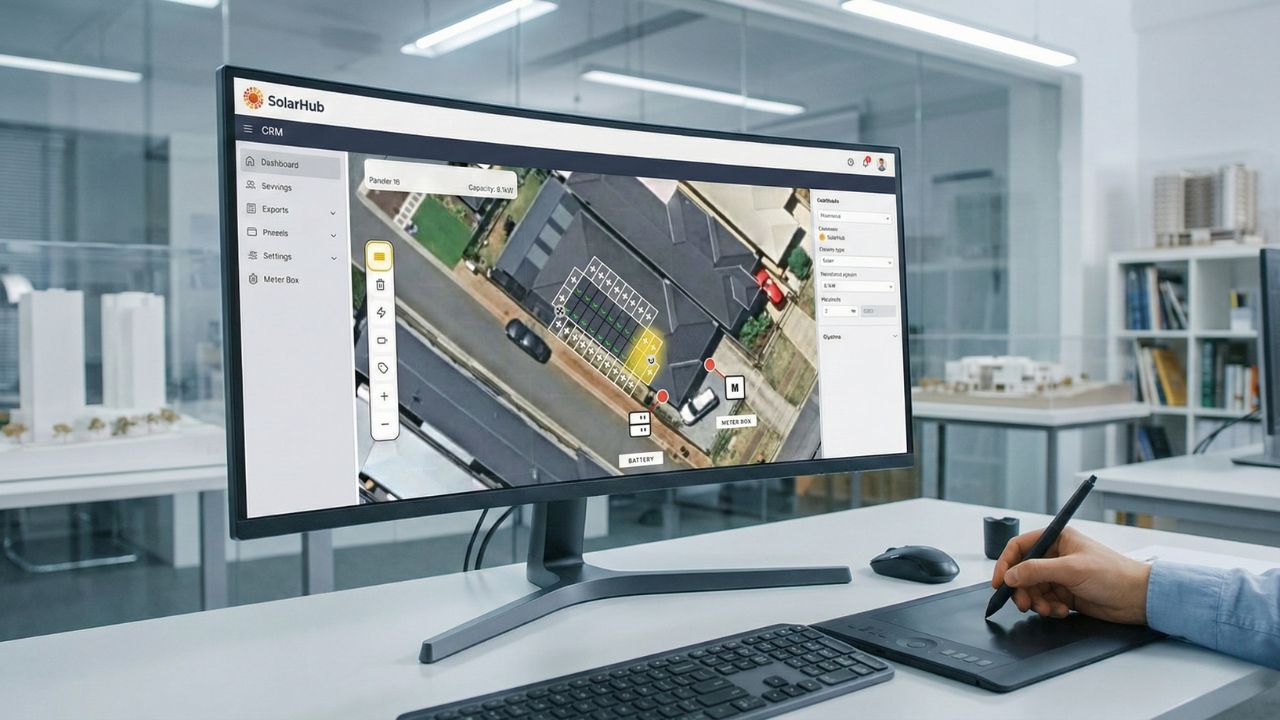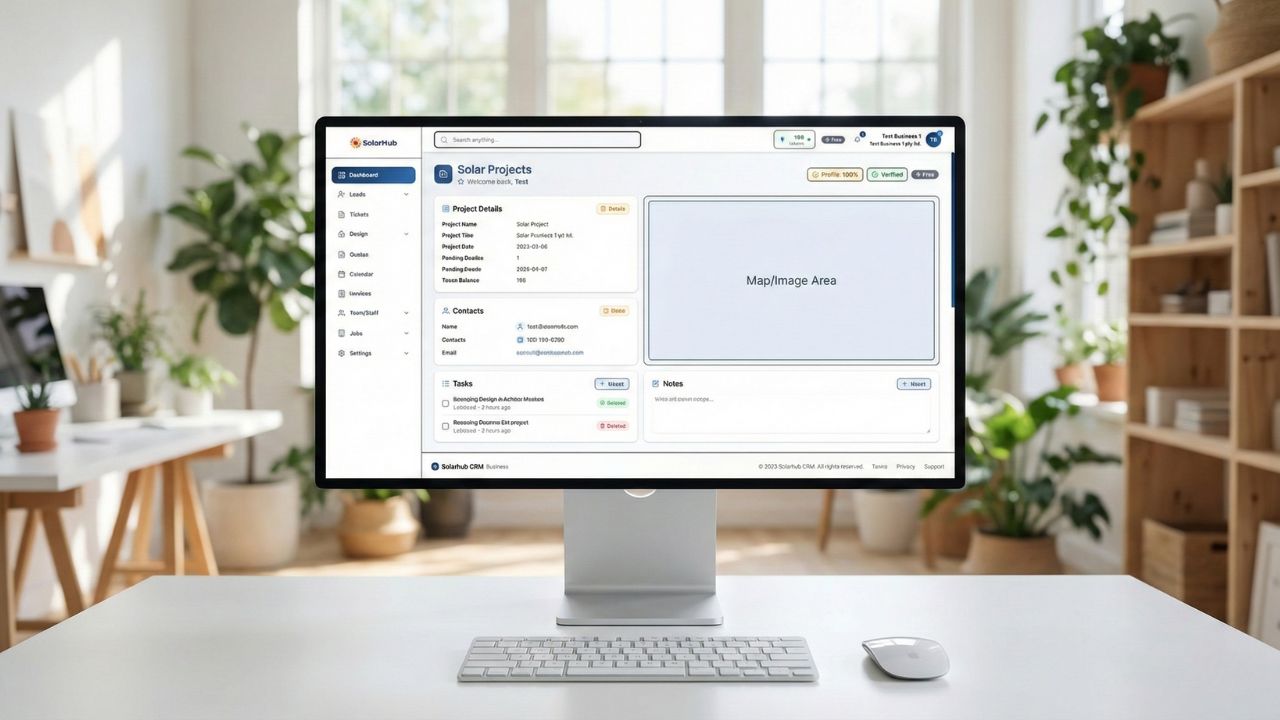Mastering Solar: The Ultimate PV System Design Tool for Australian Success
In Australia's booming solar market, staying ahead means more than just installing panels; it means designing intelligent, efficient, and profitable PV systems. For solar retailers and installers across Sydney, Melbourne, Perth, Brisbane, Adelaide, and Hobart, the right PV system design tool isn't just a luxury – it's a necessity. It’s the difference between a rough estimate and a precise, bankable proposal that wins over customers.
Are you tired of juggling multiple spreadsheets, clunky CRM systems, and separate design tools? Imagine a world where lead management, professional solar proposals, and project documentation are all seamlessly integrated. That's the power of an all-in-one platform like Solarhub, which includes a robust pv system design tool at its core, specifically tailored for the unique demands of the Australian market.
This comprehensive guide will delve into why a dedicated pv system design tool is crucial for your Australian solar business, what essential features to look for, and how Solarhub offers an unparalleled solution to elevate your operations and secure more projects.
Why a Dedicated PV System Design Tool is Essential for Australian Solar Businesses

Australia is a land of abundant sunshine, but also complex grid regulations, diverse climate zones, and varying customer expectations. To thrive, solar businesses need precision. A generic approach simply won't cut it. This is where a specialized pv system design tool becomes your most valuable asset.
The Australian Solar Landscape: Unique Challenges & Opportunities
From the tropical north to the temperate south, designing a solar system in Australia involves navigating a maze of factors:
- Diverse Climates: Intense heat in WA, humidity in QLD, and cooler temperatures in VIC all impact solar energy production and component selection. Your solar design software must account for these variations.
- Grid Connection Rules & Export Limiting: Each state and even local network distributor (e.g., Ausgrid, Energex, SA Power Networks) has specific rules regarding system size limits, feed-in tariffs, and export limiting. A sophisticated pv system design tool helps you design compliant systems, whether it's a single phase residential setup or a three phase commercial installation.
- Solar Rebates & Incentives: Navigating the STCs (Small-scale Technology Certificates) and state-specific solar rebates requires accurate system calculations and project documentation.
- Customer Expectations: Australian homeowners and businesses are increasingly savvy, demanding detailed solar proposals, accurate energy production estimates, and clear breakdowns of system prices.
An advanced pv system design tool directly addresses these complexities, allowing you to:
- Boost Accuracy: Minimise errors in system size, energy output, and financial projections.
- Save Time: Automate tedious calculations and proposal generation, freeing up your team for more sales and installations.
- Enhance Professionalism: Present polished, data-driven proposals that build trust and demonstrate expertise.
- Optimise Performance: Design systems that maximise energy production and meet specific customer load profiles.
Key Features to Look for in a Top-Tier PV System Design Tool
Not all pv system design tools are created equal. To truly excel in the Australian market, your chosen solar design software must offer a comprehensive suite of features. Here’s what to prioritise:
Accurate Roof Planning & Shading Analysis
The roof is the canvas for your PV system. A superior pv system design tool will provide advanced visual roof planning capabilities, allowing you to accurately map out PV modules and solar panels on any roof structure. Crucially, it must include robust shading analysis. This feature identifies potential obstructions (trees, chimneys, neighbouring buildings) throughout the year, calculating their impact on energy production and allowing you to optimise panel placement for maximum efficiency. Tools like SMA's Sunny Design or PVsyst excel in this area, providing detailed data for informed decisions.
Inverter & Battery Optimisation
The inverter is the brain of the PV system, and solar battery storage is becoming increasingly vital. Your pv system design tool should enable you to select and configure different inverter capacity options and integrate various solar batteries. This includes features for optimising string sizing, voltage matching, and ensuring compatibility between inverters and PV modules. The ability to simulate performance with different brands (e.g., SMA Solar, Fronius, SolarEdge) gives you flexibility.
Load Profile & Energy Production Simulation
Understanding a customer's electricity consumption is paramount. A sophisticated pv system design tool allows you to input or generate load profiles (e.g., from smart meter data or estimated usage patterns) and then run detailed solar simulation. This simulation software should predict energy production based on location-specific solar irradiation data, shading, and component efficiencies. This provides accurate financial projections and helps determine the ideal system size in kW system. Look for tools that offer time series analysis for granular insights.
Comprehensive Project Documentation & Proposals
Winning PV projects requires more than just a good design; it requires professional, easy-to-understand project documentation and compelling solar proposals. Your pv system design tool should automate the creation of these documents, including technical specifications, financial summaries, energy offset calculations, and visual layouts. Solar Proof and PVSell are known for their proposal generation features, simplifying the sales process.
Scalability for Residential & Commercial Solar
Whether you're designing a small homesolar system or a large commercial solar installation, your pv system design tool should be versatile. It should handle different system sizes, from a few kW solar to multi-kW system setups, and accommodate the complexities of business energy demands. Features like support for heat pumps and EV charging stations are also becoming increasingly important for comprehensive energy systems.
Grid Integration & Export Limiting
Navigating the grid connection requirements is critical. A good pv system design tool will help you design systems that comply with local network rules, including support for export limiting, single phase or three phase connections up to specified kVA or kW limits. This ensures your designs are not only efficient but also compliant and ready for approval.
Popular PV System Design Tools in Australia: A Comparative Look

The Australian market offers a variety of solar design software solutions, each with its strengths. Understanding these can help you appreciate the integrated approach offered by Solarhub:
- Sunny Design (SMA): A well-known option for SMA Solar inverters, offering comprehensive design and simulation capabilities, including Sunny Design Web. Users often look for release notes Sunny Design to keep up with new features.
- SolarPlus: A comprehensive platform focused on sales and design, catering to various system sizes and complexities.
- SolarEdge Designer: Tailored for SolarEdge systems, offering optimised designs for their specific inverter and optimizer technology.
- SolarProof / PVSell: Popular for their user-friendly interface and focus on generating quick, professional solar proposals and sales tools.
- PVsyst / Helioscope: High-end solar simulation software often used for detailed analysis and bankable reports, particularly for larger PV projects.
While these tools offer excellent individual functionalities, they often operate in silos. This means you might find yourself exporting data from one tool to another, managing separate customer databases, and manually updating project statuses.
How Solarhub Elevates Your Solar Business with an Integrated PV System Design Tool
Solarhub was built from the ground up to address the specific needs of Australian solar retailers and installers. It’s not just another pv system design tool; it’s an all-in-one platform that brings together every aspect of your business, ensuring seamless operations and maximum efficiency. Our integrated approach means your solar design process is deeply connected to your sales, marketing, and project management workflows.
Lead Management & Seamless Design Integration
With Solarhub, your journey from a new lead to a completed PV system is smooth and efficient. Our platform allows you to:
- Track & Nurture Every Opportunity: Manage leads from initial contact through to conversion with robust lead management features.
- Automated Data Flow: Customer data captured during lead qualification automatically populates into the pv system design tool, eliminating manual entry errors and saving valuable time.
- Smart Integrations: Connect with platforms like Facebook, Google Sheets, and landing pages to ensure all lead data feeds directly into your system.
Professional Solar Proposals with Precision
Our integrated pv system design tool empowers you to create stunning, accurate, and compelling solar proposals in minutes:
- Accurate Calculations: Leverage advanced algorithms for precise energy production estimates, ROI projections, and financial breakdowns. This includes detailed analysis for various kW system options.
- Visual Roof Planning: Our intuitive interface allows for quick and accurate visual roof planning, placing PV modules and solar panels with precision, even incorporating shading analysis.
- Customisable Templates: Brand your proposals with your company logo and colours, ensuring a consistent and professional image.
- Inverter & Battery Integration: Easily specify and simulate different inverter and solar battery configurations, providing customers with optimal energy storage solutions.
Streamlined Operations & Team Collaboration
Solarhub goes beyond just solar design, offering a complete ecosystem for your business:
- Job Scheduling: Seamlessly transition from a winning proposal to job scheduling, with calendar sync and appointment booking features.
- Team Management: Define roles, permissions, and collaborate efficiently on PV projects, ensuring everyone is on the same page.
- Lead Allocation: Implement smart routing and assignment rules to ensure leads are distributed effectively among your sales team.
- Automated Email Marketing: Keep customers engaged with automated campaigns and follow-ups, nurturing leads even after the initial proposal.
By using Solarhub, you replace the need for separate design software like Sunny Design Pro or even manual calculations, integrating these critical functions into one powerful platform. This means less friction, fewer errors, and more time focused on growth.
Maximising Your ROI with the Right PV System Design Tool

Investing in a high-quality pv system design tool like Solarhub isn't just an expense; it's an investment that yields significant returns for your Australian solar business:
- Increased Sales & Conversion Rates: Professional, accurate proposals built with a robust pv system design tool instill confidence, leading to higher close rates and more PV projects.
- Reduced Operational Costs: Automation of design, documentation, and proposal generation significantly cuts down on labour hours and administrative overhead.
- Enhanced Customer Satisfaction: Delivering precise energy estimates and visually appealing designs fosters trust and positive customer relationships, leading to referrals and success stories.
- Improved Project Profitability: Optimised system design, accurate component selection, and efficient workflow management contribute directly to healthier profit margins on every solar system.
Future-Proofing Your Business: Trends in PV System Design Software
The solar industry is constantly evolving. A forward-thinking pv system design tool should not only meet today's needs but also anticipate tomorrow's trends:
- Advanced AI & Machine Learning: Expect more intelligent recommendations for system size, component selection, and load profiles.
- Enhanced Energy Management Systems: Deeper integration with smart energy management, including heat pump controls and EV charging stations, will become standard.
- Real-time Data Integration: Seamless flow of production data from installed PV systems back into the designtool for continuous improvement and performance validation.
- Sophisticated Solar Simulation Software: More granular solar simulation and analysis, accounting for even more environmental variables.
Solarhub is committed to continuous innovation, ensuring our platform evolves with these trends, keeping your business at the forefront of the Australian solar industry. We regularly update our features, much like how users track release notes Sunny Design, to ensure you always have access to the latest capabilities.
Conclusion: Empower Your Australian Solar Business with the Right Tool
The Australian solar market presents immense opportunities, but capitalising on them requires efficiency, accuracy, and a commitment to customer satisfaction. A powerful, integrated pv system design tool is no longer optional; it's a fundamental component of a successful solar business.
Solarhub offers more than just a pv system design tool; it provides a complete, all-in-one platform engineered specifically for Australian solar retailers and installers. From initial lead capture to final project documentation, our system streamlines every step, allowing you to design with precision, propose with confidence, and manage your entire business from a single screen.
Stop wrestling with disparate software and embrace a solution that empowers your team, delights your customers, and drives your business forward. Discover how Solarhub can transform your operations and boost your bottom line.
Ready to revolutionise your solar business?
Explore Solarhub Today!

